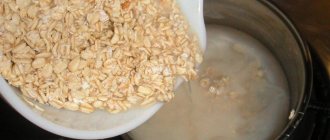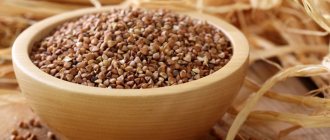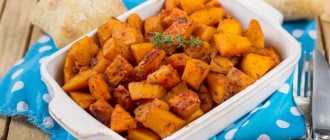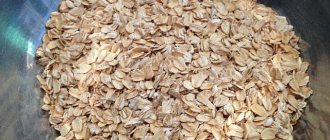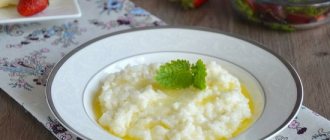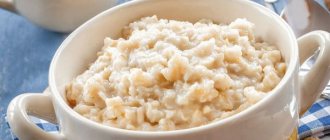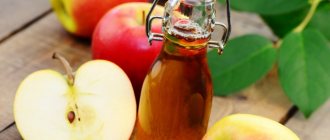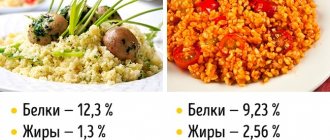Beneficial properties and harms of oatmeal with milk
Due to the large amount of vitamins and minerals contained in oats, oatmeal has the following beneficial properties:
- normalizes the functioning of the liver, kidneys and thyroid gland;
- reduces the concentration of bad cholesterol, preventing the formation of cholesterol plaques;
- reduces acidity in the stomach;
- improves mental activity;
- improves skin condition and helps prevent dermatological diseases;
- stabilizes the nervous system of the body.
In addition, the porridge is rich in fiber, thanks to which it gently cleanses the entire gastrointestinal tract, normalizing its functioning.
It activates the digestive system, preventing constipation and bloating. Complex carbohydrates, which porridge is rich in, provide an energy boost and add vitality. Oatmeal is also recommended to be included in the diet for the prevention of cancer, as it has an extremely beneficial effect on the functioning of the gastrointestinal tract.
Despite many positive qualities, this product should be treated with caution if:
- there is intolerance and allergic reactions to milk protein;
- I am overweight because milk contains a lot of fat.
- there is a lack of calcium, since this dish contains phytic acid. If it accumulates in the body, it contributes to calcium deficiency from bone tissue, washing it away.
Oatmeal contains starch. It is dangerous for those who have or are predisposed to diabetes because it is converted into glucose in the body.
Is oatmeal good for weight loss?
And more on the same topic:
Oat products, and especially porridge, have a beneficial effect on human health and help maintain a healthy weight. Thus, oatmeal is considered one of the most popular and effective products for normalizing weight.
The benefits of oatmeal for weight loss cannot be overestimated, since it:
- Cleanses the intestines and stomach;
- Activates the body's protective processes;
- Reduces cholesterol levels;
- Reduces the risk of developing heart disease and thrombosis;
- Removes harmful substances from the body;
- Gives a feeling of fullness for a long time.
- The calorie content of oatmeal with milk is low, especially if the milk is not full-fat.
Nutritional and energy value of oatmeal with milk
100 g of oatmeal contains 358.2 kilocalories, of which:
- 12.3 g protein;
- 59.5 g carbohydrates;
- 6.1 g fat;
- 12 g water;
- 4.51 g fatty acids.
The main value of oatmeal is the large amount of vitamins and minerals it contains.
| Useful elements | Content | Benefit |
| Vitamin B1 | 0.5 mg | They help improve the functioning of the circulatory, digestive and nervous systems, and prevent cardiovascular diseases. |
| Vitamin B2 | 0.1 mg | |
| Vitamin B3 | 1.1 mg | |
| Vitamin B4 | 94 mg | |
| Vitamin B5 | 0.9 mg | |
| Vitamin B6 | 0.27 mg | |
| Vitamin B9 | 29 mg | |
| Vitamin E | 3.4 mg | Removes toxins. |
| Potassium | 362 mg | Maintains the fluid composition of cells. |
| Sulfur | 81 mg | Improves the appearance of the skin. |
| Phosphorus | 349 mg | Part of bone tissue. |
| Magnesium | 116 mg | Participates in enzymatic reactions. |
| Chlorine | 70 mg | Regulates water-salt balance. |
| Calcium | 64 mg | Structures bone material. |
| Silicon | 43 mg | Helps absorb nutrients entering the body. |
| Sodium | 35 mg | Provides maintenance of water-salt balance. |
| Manganese | 5 mg | Improves the functioning of the nervous system. |
| Iron | 4 mg | Its deficiency affects hemoglobin levels. |
It is customary to eat porridge in the morning, because the beneficial substances from it are quickly absorbed and give the body a charge of vigor and strength for the whole day.
Recipes
Oatmeal is cooked in different ways; there are 3 main recipes for preparing oatmeal:
- whole grain porridge;
- instant cereals;
- "Hercules".
Whole grain oatmeal is prepared as follows:
- the amount of water to the porridge should be 3 to 1;
- initially put water on the fire;
- the porridge is poured into hot water and cooked for 45 – 90 minutes;
- Remove from the stove and cool for 10-15 minutes.
Instant oatmeal requires nothing more than hot water or milk. The liquid is poured into the porridge and steamed for 5-10 minutes, after which the porridge is ready for consumption. Additionally, you can add butter or vegetable oil to the dish; the second should be added only after the oatmeal becomes warm, but not hot.
Hercules flakes are prepared differently:
- the flakes are poured into the pan in a ratio of 2.5 to 1;
- filled with water;
- boil for 10-15 minutes;
- cool for 5-10 minutes.
Cereals cook differently than whole grains due to their light weight and density, causing them to continually float to the surface of the liquid.
The calorie content of oatmeal varies depending on how it is prepared: with water or milk. In general, the calorie content of the finished dish is relatively low, which makes this dish one of the best ways to maintain your weight at normal levels and keep your body in good shape, while satiating it for several hours in advance.
The most important thing is to eat oatmeal in moderation and not every day, since this dish still has a high gluten content in its composition, which significantly inhibits the functioning of the stomach.
Article design: Vladimir the Great
Calorie content of oatmeal with milk
Calorie content of fresh oatmeal with milk
The energy value of fresh oatmeal with milk depends on the type of cereal or flakes and the fat content of the base.
On average, the calorie content of 100 g of porridge is approximately 110-120 kcal, provided that milk of medium fat content is used, that is, 1.5%. This means that in one serving of porridge, which is about 200 g, which you are used to eating for breakfast, there will be approximately 225 kcal, and in a standard dinner plate - 275 kcal.
If you use milk with a fat content of 2.5%, then the energy value of unleavened oatmeal will increase by 10 kilocalories, and if you use homemade village milk, then by 15-20 kcal. But skim milk will reduce the energy value of porridge by 10 kilocalories. This means that 100 g of porridge prepared with skim milk will contain 100 kcal.
All calculations of energy value are valid provided that unleavened milk porridge is prepared without additives.
Oatmeal with milk and sugar
The calorie content of oatmeal cooked with milk and added sugar depends directly on the amount added. According to the classic recipe, 100 g of porridge contains 10 g of sugar. And, since 1 g of sugar = 4 kilocalories, you can calculate the calorie content of 100 g of the finished product as follows:
10 g sugar * 4 kcal +110 kcal (porridge) = 150 kcal
Calories in oatmeal with sugar and salt
With the addition of sugar, the calorie content of oatmeal will increase. But adding salt to the porridge does not change its calorie content, because table salt contains absolutely no calories. Therefore, nutritionists strongly recommend preparing oatmeal as a side dish for meat, fish or vegetables.
Calorie content of oatmeal steamed with milk
The calorie content of oatmeal steamed with milk, provided that the oatmeal is without additives, will be 110-120 kcal. But if oatmeal contains added sugar, dried fruits or berries, then its energy value will increase by the calorie content of the additional products.
Calories in oatmeal with butter
The energy value of milk porridge with butter is quite high, due to the amount of fat in dairy products.
The calorie content of 100 g of oatmeal with 10 g of butter without sugar is 182 Kcal, i.e. a full serving of 250 g “weighs” 455 Kcal
In the basic recipe, it is customary to add 10 g of butter per 100 g of oat milk porridge. Since the energy value of 100 g of oil is approximately 720 kcal, then, accordingly, 10 g is 72 kcal.
That is, according to the basic recipe, 100 g of porridge:
- with butter – 182 kcal (72 kcal butter + 110 kcal milk porridge);
- with butter and sugar - 222 kcal (72 kcal butter + 40 kcal 10 g sugar + 110 kcal porridge).
If you increase the amount of sugar or oil slightly, then the energy value of the finished product will be higher.
Calorie content of oatmeal with milk without additives
Oatmeal with milk, the calorie content of which is 110 kcal, of which:
- 2 g proteins;
- 1 g fat;
- 2 g carbohydrates.
Provided that the porridge is cooked without adding butter, sugar, honey and various berries, fruits and nuts. It is thanks to this value coefficient that oat milk porridge saturates the body and gives a feeling of fullness for a long time.
If you add water - calorie content
The calorie content of oatmeal cooked with milk with the addition of water is lower than just porridge with milk, exactly as much as the amount of water in the dish. The energy value of oatmeal with water is 80 kcal per 100 g (0.8 kcal per 1 g of porridge). If you mix water and milk in half, the calorie content of such a dish will be approximately 90 kcal per 100 g of product.
This means that the more water and less milk, the lower the calorie content, and vice versa.
Video of preparing oatmeal with milk and water:
Oatmeal with milk and honey
Oatmeal with milk, whose calorie content is approximately 110 kcal, with the addition of various additives increases its energy value. But, thereby, the benefits of the product also increase. Based on this, very often honey is added to oat milk porridge.
The energy value of honey is 304 kcal per 100 g, respectively 3.04 kcal per 1 g. According to the recipe, 20 g of honey is added per 100 g of porridge, which means the calorie content of 100 g of porridge with honey will be 170.8 kcal.
Properties of oatmeal with milk
The product is rich in vitamins, micro- and macroelements necessary for humans. Also, rolled oats with milk have the following properties:
- 100 grams of porridge contains ¼ of the daily requirement of fiber;
- of all products, the dish has the most optimal ratio of proteins, fats, carbohydrates and fiber;
- Great for a healthy diet, but if you need to lose weight quickly, you should use skim milk or just water.
Important! Oats contain valuable vegetable protein. But this substance is best absorbed in combination with animal protein. Therefore, porridge is often cooked in milk, especially for children. Milk and butter enrich the already valuable composition of oatmeal.
Benefit
Hercules cooked in milk is useful for the following reasons.
- The dietary fiber contained in oats helps remove cholesterol from the body.
- Oatmeal is a real “beauty porridge”. A large number of vitamins strengthen hair, nails, and rejuvenate the skin.
- For older people, this is the prevention of age-related joint pain, osteoporosis, and tuberculosis.
- Hercules is a natural antioxidant that can cleanse the body of waste and toxins.
- The dish is not forbidden to eat if you have diseases of the gastrointestinal tract, and if you have gastritis, it even alleviates the condition.
For the women's body
Every lady strives to maintain youth, health and a blooming appearance for many years. This is not easy for a fragile female body, which ages faster than a male body. Oatmeal cooked with milk can become a faithful assistant in the fight for beauty. There are at least 5 reasons why the weaker sex is recommended to include this delicacy in their diet.
- The presence of a large amount of vitamins, especially B and E. B vitamins make the skin moisturized, smooth and pleasant in color, and the nervous system more stable. Vitamin E strengthens the reproductive system.
- High magnesium content improves metabolism. This is especially true for older women, when metabolism slows and maintaining a normal weight becomes more difficult.
- The presence of iron, which is urgently needed after menstrual blood loss. The nervous system, skin, hair, and nails also need this microelement.
- For women who are losing weight, this porridge will do a good job - it will keep you feeling full for a long time. Only in this case you need to cook it with low-fat milk.
- A large amount of fiber generally has a beneficial effect on the body of the fairer sex: digestion works like clockwork, toxins are eliminated faster, and the skin maintains tone.
For men
Men should also love this dish with all their hearts. Let's give some reasonable arguments.
- The body of the stronger half of humanity especially needs vitamin E, which is involved in the production of testosterone, the male sex hormone.
- A large amount of antioxidants protects male organs from diseases.
- Boys and men involved in bodybuilding respect oatmeal with milk for its help in building muscle mass.
- The quality of seminal fluid and sperm activity improves, which means the ability to procreate increases.
For children
Scientists have proven that regular consumption of oatmeal in the morning improves schoolchildren's academic performance. Such a breakfast ensures a slow supply of glucose to the brain, and this has a beneficial effect on the child’s memory and attentiveness. Oatmeal is good for children for several other reasons.
- A large number of vitamins, macro- and microelements contained in rolled oats strengthens the young body’s immunity and resistance to disease.
- The rich iron content is an excellent prevention of anemia.
- An energizing breakfast that will leave your child feeling energetic and full until school lunch.
- Porridge cooked with milk is rich in calcium, without which a child cannot grow and develop normally.
For pregnant
For ladies in excellent condition, eating such a dish is very useful. A pregnant woman's body urgently needs iron and folic acid. Oatmeal is a real storehouse of these elements. Here are a few more reasons for including rolled oats in the diet:
- less manifestation of toxicosis due to vitamin B6;
- a large amount of fiber eliminates constipation, which often bothers pregnant women;
- In an interesting situation, women sometimes experience worsening condition of their nails and hair, and oatmeal will help cope with this problem.
If you eat rolled oats during pregnancy in moderate quantities, then there are no contraindications to it. Sometimes women feel sick from milk, then they should cook the porridge in water.
Fact! The American Pregnancy Association included oatmeal in the top 12 healthiest foods for expectant mothers.
Harm and contraindications
When consumed in moderation - several times a week - oatmeal will not cause harm. But there are still a few contraindications:
- intolerance to gluten and grains, which is quite rare;
- if you are allergic to lactose, you should cook porridge in water or use coconut milk;
- excessive consumption of the product can lead to the accumulation of phytic acid in the body, which interferes with the absorption of calcium;
- milk is perfectly absorbed by children, but with age this ability deteriorates, especially after 40 years, and then it is better to cook porridge in water.
Oatmeal recipes with milk
There are many recipes and methods for preparing oatmeal with milk.
Recipe for cooking porridge on the stove
Necessary:
- 250 g milk;
- 125 g oatmeal;
- 1 g salt;
- 10 g butter (optional).
Preparation:
- Bring the milk to a boil, stirring occasionally.
- Add the cereal and boil for 10-15 minutes (cooking time depends on the grinding of the grains).
- Remove the container from the heat, cover with a lid and set aside for a while so that the porridge steams.
- Add oil and stir.
Oven recipe
Necessary:
- 600 g milk;
- 200 g cereal;
- 75 g sugar;
- 25 g butter.
Preparation:
- The cereal is poured with cold water and left for several hours.
- Afterwards, the cereal is washed, poured with milk, sugar is added and boiled for 35-40 minutes over an open fire.
- Transfer the porridge to a baking container, add oil and place in the oven.
- Bake the porridge for about an hour.
Multicooker recipe
Necessary:
- 100 g oatmeal;
- 450 g milk;
- 25 g sugar;
- 1 g salt;
- 10 g butter.
Preparation:
- Pour oatmeal into the multicooker container, add sugar, salt and milk.
- Select the “porridge” or “milk porridge” program.
- After the time specified by the program, open the multicooker lid, add oil and stir.
Microwave oatmeal recipe
Necessary:
- 100 g oatmeal;
- 250 g milk;
- 20 g sugar;
- 1 g salt.
Preparation:
- Oatmeal is poured into a microwave-safe bowl, milk, sugar and salt are added.
- Place the dishes in the microwave at full power for 5-7 minutes.
- Take it out and stir it.
You can add various fruits and nuts to porridges prepared according to these recipes. The calorie content will increase by the calorie content of the added products.
What types of oatmeal are there and which is healthier?
Oatmeal is a processed oat grain, cleared of chaff. The grain is sold both as grain itself and as flattened flakes.
Today oatmeal is called:
- whole grains;
- instant steamed cereals;
- dry flakes - “Hercules”;
- steamed flakes.
Of all the types of this porridge, the best is grain.
This oatmeal is recommended for athletes and those on a diet.
Porridge made from whole grains will take about an hour to cook, which is inconvenient for a modern person; moreover, such porridge should not be consumed by children under 3 years of age. At the same time, such cereals contain the most vitamins and microelements.
Porridge from a bag (instant cooking) is neither particularly nutritious nor particularly healthy. This porridge is chopped and flattened grain, which is boiled with steam. The sachets often contain flavoring additives and flavor enhancers; such porridges also often contain sugar, which will turn ordinary oatmeal with milk into a hypercalorie product.
Typical for people living in the former republics of the once mighty country, oatmeal is associated with the Hercules brand, under which oatmeal was produced for cooking in the Soviet Union.
These flakes are produced as follows:
- the grain is polished:
- cleared of husks and impurities;
- cut in half;
- flattened.
This porridge takes 12-17 minutes to cook; the caloric content is higher than that of its green grain counterpart, but lower than that of instant porridge. The usefulness of this type of porridge is also at the same level - between “fast” porridge and green grain porridge.
Calorie content of oatmeal with additives
To find out the energy value of milk oatmeal with additives, you only need to know the calorie content of the additional products.
| Additional products | Kcal per 100 g | Amount added per 100 g of porridge | Energy value of 100 g of porridge with additives |
| Raisin | 299 | 15 | 154,85 |
| Walnut | 654 | 10 | 175,40 |
| Peanut | 567 | 10 | 166.70 |
| Banana | 89 | 40 | 145,60 |
| Cranberry | 46 | 50 | 133,00 |
| Peach | 39 | 50 | 129.50 |
| Apple | 52 | 30 | 125,60 |
This table will help you determine the choice of ingredient for porridge and calculate the energy value of a serving of the finished product.
Harm of oatmeal
Oatmeal also has its disadvantages. There are not many of them, but for many people who suffer from intolerance to certain substances, this product is contraindicated.
The main disadvantages of this porridge are:
- Contains phytin. It is dangerous because it accelerates the process of calcium excretion from the body, which increases the likelihood of bone fragility. Despite the fact that oatmeal contains a lot of calcium, it simply does not have time to be completely absorbed due to the presence of phytin in the product. Therefore, oatmeal should not be consumed every morning, but every other day, otherwise you can develop osteoporosis in 3-4 years of constant consumption of this porridge.
- Oatmeal contains gluten – the same gluten that helps create a protective barrier on the stomach mucosa can become fatal for people who cannot tolerate this substance in food, as it can simply stop the process of digestion of food by the stomach. Thus, oatmeal should not be consumed by children under 11 months of age, since gluten significantly impairs digestion, which can lead in the future to a disease such as celiac disease - a process of degeneration of the intestinal villi, in which these same villi cannot absorb nutrients.
- Oatmeal often causes diabetes due to the fact that it contains a lot of starch, which is converted into sugar by the liver during digestion.
- The calorie content of oatmeal is 340-390 kcal per 100 g of dry cereal, which is quite a lot, but this product is not consumed dry, but boiled, which reduces the calorie content due to the fact that the dish contains a lot of liquid. So, oatmeal with milk contains 106 kcal, and with water – 88-90 kcal per 100 g.
Recipes for oatmeal with milk and additives
Oatmeal with milk, the calorie content of which will change with the addition of various additives, will be tastier and healthier.
Oatmeal with banana
Necessary:
- 450 g milk;
- 80 g oatmeal;
- 1 banana;
- 15 g sugar.
Preparation:
- Boil the milk, add cereal and sugar and cook over low heat for 15 minutes.
- Remove the pan from the heat and add chopped banana to the porridge.
- Stir.
You can simply cut the banana into pieces or mash it into a puree with a fork.
Oatmeal with walnuts
Necessary:
- 450 g milk;
- 85 g flakes;
- 30 g sugar;
- 50 g nuts.
Preparation:
- The milk is brought to a boil and cereal and sand are added.
- Cook for about 15 minutes.
- Meanwhile, the nuts should be peeled and chopped into coarse crumbs with a knife.
- The nuts are poured into the finished porridge and boiled for a few more minutes.
You can use any nuts.
Chocolate oatmeal
Necessary:
- 550 g milk;
- 225 g oatmeal;
- 50 g cocoa;
- 50 g sand;
- 25 g butter.
Preparation:
- Cocoa and sugar are diluted in already heated boiling milk.
- Then add the cereal and cook over low heat for another 20 minutes.
- Remove the pan from the heat and add oil.
Before serving, the dish can be decorated with pieces or crumbs of chocolate.
Oatmeal with coconut milk
Any recipe for milk oatmeal is taken as a basis, but half of the milk is replaced with coconut milk. It will enrich the product with vitamin D, calcium and magnesium.
Oatmeal with chia seeds
You need to take your favorite milk porridge recipe as a basis, and sprinkle the dish with chia seeds before serving. The seeds will increase the amount of fiber in the dish, making the dish more nutritious.
What are the harms of constantly eating oatmeal?
Oatmeal is certainly healthy, but it also has its drawbacks .
The dish contains phytic acid, which slows down the processes of calcium production in the body. Therefore, people suffering from osteoporosis and calcium deficiency should limit their consumption of oatmeal.
The gluten content, when consumed daily, can cause various allergic reactions, and a high content of this component in the intestines can worsen the functioning of the digestive system.
Oatmeal is still porridge, and its calorie content is quite high. By constantly eating oatmeal, you can gain an extra couple of kilograms. Limit the consumption of oatmeal, they contain starch, which tends to be converted into sugar; overconsumption of oatmeal can lead to diabetes.
Oatmeal is a delicious, healthy and nutritious product . Its calorie content is lower than others, and there are a lot of recipes for its preparation. Alas, with all these positive properties there are also disadvantages; remember that constant consumption of oatmeal can do more harm than cure, but if you know when to stop, oatmeal will become an excellent ally in restoring the body, and will also improve your mood and vitality.
Is it possible to lose weight by eating oatmeal with milk?
Many diets include oatmeal cooked in water. There are diets that suggest including milk oatmeal in your diet. When prepared correctly, consumed in moderation and counting calories, it will cleanse the intestines, eliminate the feeling of hunger and promote rapid weight loss.
Basic diets on milk oatmeal last from seven to fourteen days, and, as practice shows, they bring very good results. There are more gentle diets; they can last from twenty-one days to six months.
With an oatmeal diet, vegetables and unsweetened fruits are allowed in large quantities, which can be eaten on their own or added to the porridge itself. Drinking plenty of clean water or green teas with the addition of ginger and lemon will be beneficial.
Properly prepared oatmeal with milk, low in calories, consumed in the morning, will saturate the body for a long time and enrich it with vitamins and minerals.
And thanks to the addition of various fruits, honey, and nuts, breakfast can be made not only healthy, but also varied, tasty, and nutritious.
Article design: Svetlana Ovsyanikova
A few secrets for making oatmeal
To prepare delicious oatmeal - no matter with milk or water - you need high-quality cereals, and it is best to use whole grains or oatmeal flakes. They are rich in minerals, all kinds of vitamins and various beneficial substances.
If you don't have time to prepare whole-food porridge, you should use processed instant oats. Before purchasing them, carefully study the composition of the cereal; you should also familiarize yourself with the recipe for preparing the dish that the manufacturer offers.
The method of storing dry oatmeal is simple: the packaging must be hermetically sealed, since cereals or flakes can absorb moisture and will be unfit for consumption.
How are they useful?
Including oatmeal in the diet helps lower cholesterol levels and also reduces the risk of heart attack, stroke, and atherosclerosis. To increase the body's protective functions and normalize the functioning of the nervous system, you should consume oatmeal daily.
The likelihood of cholesterol plaques rapidly decreasing. Those who eat oatmeal every day are familiar with the feeling of a surge of strength and energy. The properties of porridge help fight drowsiness, irritability, depression, and achieve complete moral calm.
How are they useful?
The product reduces the risk of tuberculosis, as it fights the bacilli that cause it. The beneficial qualities of the flakes have a positive effect on the functioning of the thyroid gland. Many athletes include porridge in their diet because it strengthens muscle and bone tissue and removes toxins and waste from the body.
Oatmeal is especially useful for those people who cope with:
- Lack of immunity.
- Diabetes mellitus.
- Diseases of the circulatory system.
- Deterioration of brain function, memory loss.
- Brittle nails and hair.
The main uniqueness of the product is that, despite its relatively high calorie content, it remains easily digestible, and complex carbohydrates are spent on energy saturation.
Eating a serving of oatmeal is a simple and at the same time ideal healthy breakfast option. Despite the richness of the product in proteins and carbohydrates, it is very easily absorbed in the body.
However, simplicity only applies to the cooking process. The same cannot be said about the composition of the dish. The finished portion contains a large amount of vitamins and microelements. Oatmeal is not only a dietary food, but also contains many substances that are important for maintaining the body in good shape.
Even periodic consumption of oatmeal will have a positive effect on the body. If you eat it systematically, then changes in a positive direction are guaranteed - this applies to both the functioning of the gastrointestinal tract and all systems and organs.
However, people who have hereditary diseases or suffer from celiac enteropathy should not eat oatmeal, because oats contain proteins that contribute to food allergies and digestive disorders (gluten and related avenin, hordein). The product is not recommended for persons with renal or heart failure.
List of useful properties:
- helps normalize sugar levels in people with diabetes due to its low glycemic index;
- contains inositol, which counteracts the formation of cholesterol plaques;
- strengthens the body's immune system due to the high content of natural antioxidants;
- can become a prophylactic against gastritis, stomach and duodenal ulcers;
- rich in fiber and prevents gastrointestinal disorders;
- has a healing effect and also reduces the risk of developing stomach cancer;
- contains lignans that strengthen the cardiovascular system and help prevent heart and vascular diseases;
- removes carcinogenic substances from the body;
- improves the functioning of the endocrine system;
- makes bones and teeth strong;
- is a natural remedy for stress and depression;
- helps with lethargy, apathy and muscle pain;
- reduces the risk of type II diabetes;
- cleanses the body of toxins;
- improves the functional state of the liver;
- lowers cholesterol through beta-glucan, a special type of soluble fiber;
- fights intestinal dysfunction and constipation.
